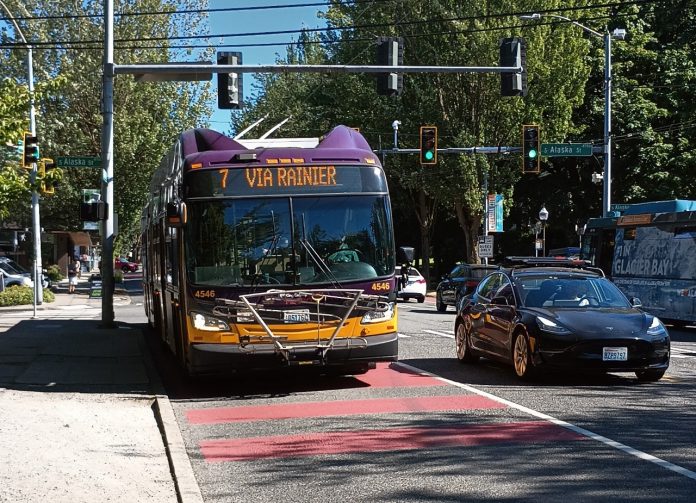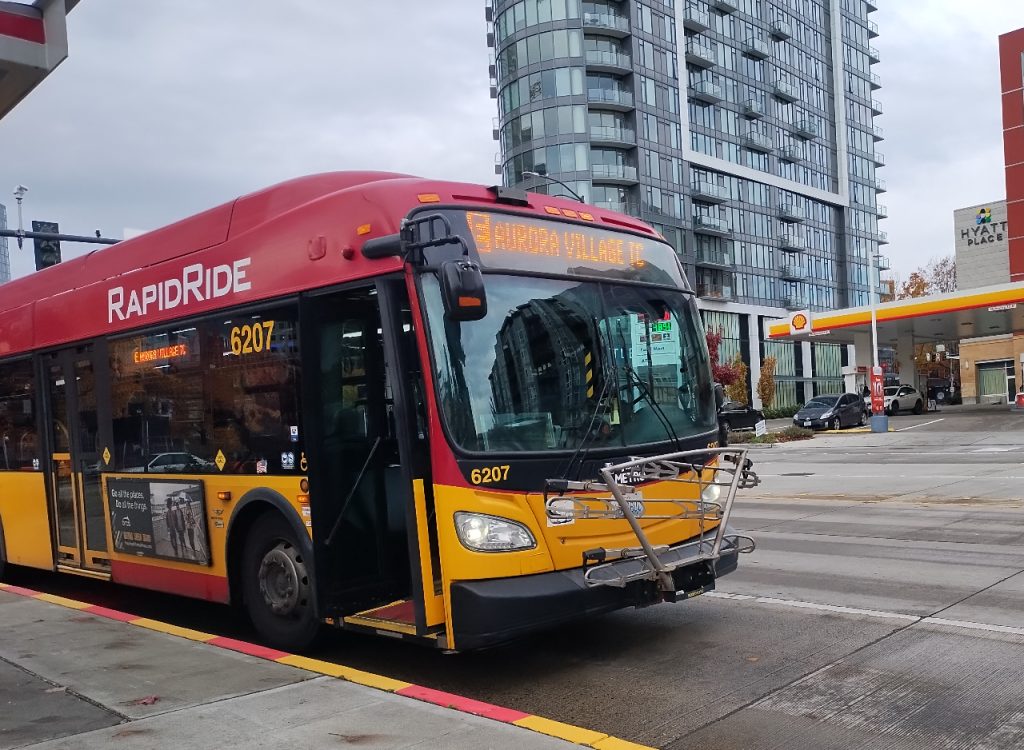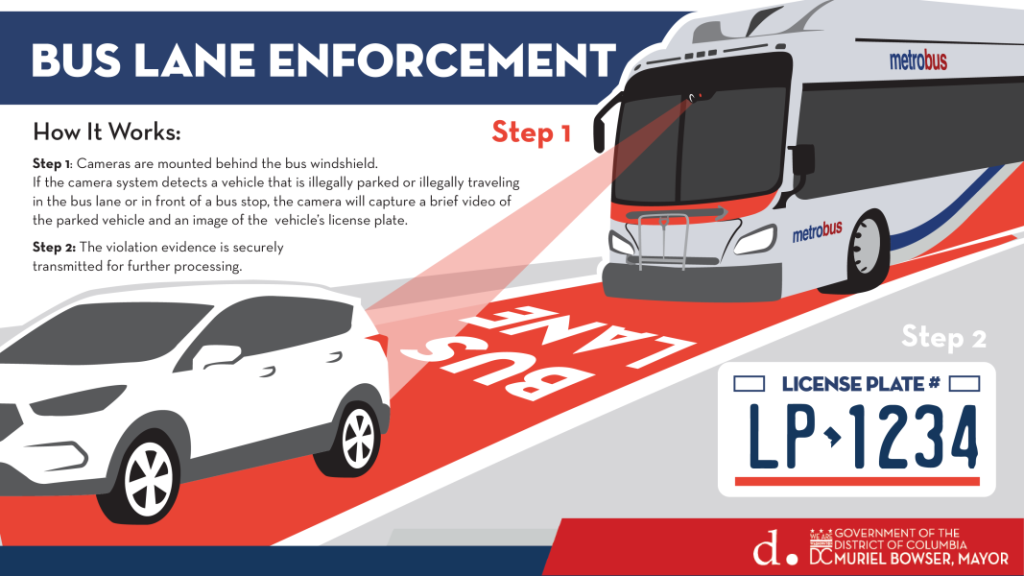
King County Metro quietly launched a pilot program earlier this month making it the first transit agency in the state to test out cameras mounted directly on coaches to enforce bus lanes and ticket violators. The authority for the cameras is just a few months old and exclusive to agencies that operate in King County, thanks to a new state law approved by the Washington State Legislature earlier this year.
The move was announced via a post on the agency’s Metro Matters blog, after an item noting the pilot was included in the Metro Transit Operations Bulletin, the internal newsletter distributed at Metro bases. The 60-day pilot program will be in effect on two coaches, one on Rainier Avenue’s Route 7 and one on Aurora Avenue’s RapidRide E, two routes with significant stretches of transit lanes.
No drivers will be cited during this evaluation period, and they won’t even be notified with a warning. The two buses will simply “assess and evaluate how often private vehicles illegally use bus lanes.” That data that will determine how effective on-board cameras deployed across the system could be. The cameras started capturing license plates on November 6.
“Too often, private vehicles take advantage of red bus lanes or bus stops intended for King County Metro and other transit agencies – a move that can lead to bus delays or dangerous collisions. Additionally, slowing down buses wastes riders’ time and taxpayers’ money,” the post, authorized by Metro spokesperson Jeff Switzer, noted.
It will be up to the City of Seattle and the other jurisdictions in which Metro operates to establish a program to cite drivers using these onboard cameras. Seattle already operates five automatic transit lane cameras at fixed locations, including one on Aurora Avenue, one on the West Seattle Bridge, and three Downtown.
Metro’s data notes that on-time performance along the Route 7 is currently at 73%, well short of its goal of 80%. Metro defines on-time performance as no more than 5.5 minutes late or 1.5 minutes early, relative to the route’s posted schedule. Enforcing bus lanes in Columbia City and Hillman City will likely improve on-time performance marginally, but the biggest gains for Route 7 riders are unlikely to come until the Seattle Department of Transportation (SDOT) adds transit priority to the segment of Rainier Avenue north of I-90, where traffic congestion is most common.

On-time performance on the RapidRide E is at 75%, which ranks the route among the most perpetually delayed RapidRide routes. The longer-term Aurora Avenue corridor project is intended to add more speed and reliability improvements to the E Line, with an internal Metro study from 2022 noting the big potential for time savings for both Route 5 and RapidRide E coaches with bus lanes on the Aurora Bridge.
Onboard cameras are already enforcing bus-only lanes in cities across the US, including in Washington, D.C, and New York City. Just this fall, New York’s MTA announced an expansion of bus-mounted enforcement across all five boroughs, with 1,000 buses set to be equipped with cameras by the end of September. The expansion began with a 60-day warning period that is set to end soon. Once penalties are in effect, drivers will receive $50 citations that escalate to $250 after they accrue repeated violations.
Washington, D.C.’s Clear Lanes program has been operating since last year, becoming the first city in the country to enforce illegal parking at bus stops along 31 different bus routes that have bus lanes along some segment of their route. In less than a year, the city issued over 147,000 citations.

Initial data from the MTA shows that the use of cameras has increased bus speeds on streets with dedicated lanes by 5%, but also reduced collisions on those streets by 20%. Both Aurora and Rainier Avenue in Seattle see some of the highest crash rates in the city, so cameras on buses have the potential to provide benefits beyond just keeping buses moving. According to Metro, there have been 123 collisions between Route 7 buses and private vehicles since the beginning of 2023, with a very similar number seen on the RapidRide E’s route.
Metro is acting quickly to use its new authority to try out this technology. Under House Bill 2384, approved by the legislature this spring, only transit agencies operating in counties with more than 1.5 million people — meaning just King County — can enforce bus only lanes with on-board cameras. But cities with a bus rapid transit (BRT) route operating within their borders, such as Metro’s RapidRide, Community Transit’s Swift lines, or Sound Transit’s future Stride bus lines, can also enforce transit lanes via fixed cameras, something that the legislature had previously restricted to only Seattle.
The new law also expands authority to add automatic speed cameras to improve traffic safety. That includes explicitly granting cities the ability to install cameras on the crash-prone state highways running through their borders, and to have non-sworn officers review and send out traffic infractions. Previously, the state had restricted this right to sworn officers, which created procedural logjams given the staffing shortages facing many police departments.
Wider deployment of direct camera enforcement in bus lanes could disarm one major argument against adding transit priority — that cities like Seattle don’t have currently have enough traffic enforcement capabilities. Just this week, the Seattle City Council approved a request for a study looking at when and where SDOT adds bus-only lanes. That move seemed to signal a desire to re-examine the city’s priorities around making space for buses, responding to opposition to 24-hour bus lanes through Westlake, Fremont, and Ballard.
Nonetheless, if Metro is able to effectively enforce its dedicated lanes and send that data over to the City of Seattle, it could mark a sea change in keeping bus lanes clear and speeding up some of the region’s most perpetually delayed routes.
Ryan Packer has been writing for The Urbanist since 2015, and currently reports full-time as Contributing Editor. Their beats are transportation, land use, public space, traffic safety, and obscure community meetings. Packer has also reported for other regional outlets including BikePortland, Seattle Met, and PubliCola. They live in the Capitol Hill neighborhood of Seattle.



